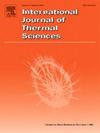Flow characteristic and solidification behavior in laser wire deposition with assistance of ultra-high frequency induction (UHF)
IF 4.9
2区 工程技术
Q1 ENGINEERING, MECHANICAL
International Journal of Thermal Sciences
Pub Date : 2025-03-06
DOI:10.1016/j.ijthermalsci.2025.109834
引用次数: 0
Abstract
UHF induction-assisted laser (UHFIAL) deposition is extensively regarded as an effective method in suppressing defects which causes by concentrated thermal input. The introduced induction heat not only can alleviate the temperature gradient of the molten pool but also refine the grain size of microstructure. To further understand the complicated influence mechanism of contactless induction heat on the hybrid deposition, a 3D numerical model coupled with multi-physical fields such as heat transfer, fluid flow, composition transport is developed. The results show that the induction heat slightly increases the maximum temperature of the molten pool and plays a role in slow-cooling effect for the deposited track. The electromagnetic stirring effect derived from electromagnetic force alters the flow pattern of the liquid metal, accelerating the flow velocity of the molten metal in the molten pool. Research on the inductive heating parameters indicates that increasing the current intensity/frequency can improve the maxim temperature of the molten pool and accelerate the flow velocity of the molten metal. The grain morphology and trends in the microstructure evolution can be effectively predicted by combining of cooling rate G∗R and shape control factor K, which is experimentally and numerically validated. Under the action of electromagnetic stirring, increasing the current frequency/intensity can both effectively refine the grain size of microstructure. The samples exhibit better wear performance due to fine grain strengthening.
求助全文
约1分钟内获得全文
求助全文
来源期刊

International Journal of Thermal Sciences
工程技术-工程:机械
CiteScore
8.10
自引率
11.10%
发文量
531
审稿时长
55 days
期刊介绍:
The International Journal of Thermal Sciences is a journal devoted to the publication of fundamental studies on the physics of transfer processes in general, with an emphasis on thermal aspects and also applied research on various processes, energy systems and the environment. Articles are published in English and French, and are subject to peer review.
The fundamental subjects considered within the scope of the journal are:
* Heat and relevant mass transfer at all scales (nano, micro and macro) and in all types of material (heterogeneous, composites, biological,...) and fluid flow
* Forced, natural or mixed convection in reactive or non-reactive media
* Single or multi–phase fluid flow with or without phase change
* Near–and far–field radiative heat transfer
* Combined modes of heat transfer in complex systems (for example, plasmas, biological, geological,...)
* Multiscale modelling
The applied research topics include:
* Heat exchangers, heat pipes, cooling processes
* Transport phenomena taking place in industrial processes (chemical, food and agricultural, metallurgical, space and aeronautical, automobile industries)
* Nano–and micro–technology for energy, space, biosystems and devices
* Heat transport analysis in advanced systems
* Impact of energy–related processes on environment, and emerging energy systems
The study of thermophysical properties of materials and fluids, thermal measurement techniques, inverse methods, and the developments of experimental methods are within the scope of the International Journal of Thermal Sciences which also covers the modelling, and numerical methods applied to thermal transfer.
 求助内容:
求助内容: 应助结果提醒方式:
应助结果提醒方式:


